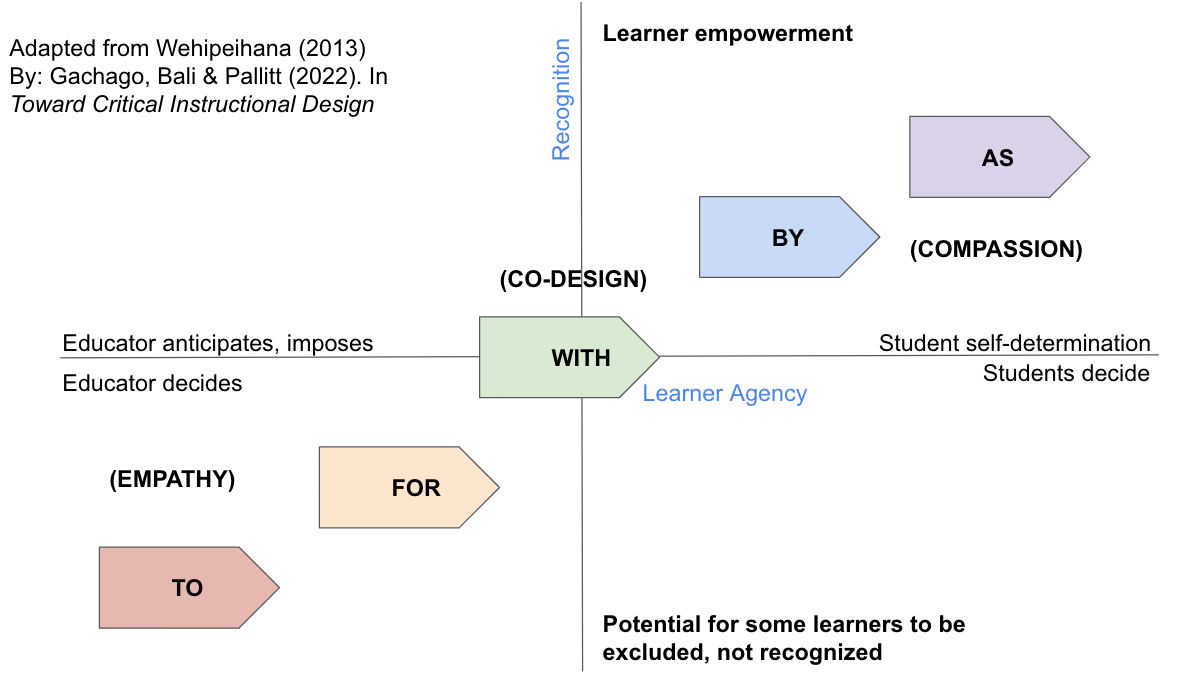1.4 Discussion Activities (20 minutes each)
The following discussion activities are prepared by Open Education Instructional Designer Veronica Vold to support individual or group study with the presentation video recording. These activities are intended to encourage reflection, analysis, and application of key takeaways.
Discussion Activity 1: Analyze A Current Open Project
Using Maha Bali’s 4 P’s of purpose, process, people, product, and the TRIZ criteria for reproducing oppression, analyze one of your current open projects:
- Who appears in your project? Remember Maha’s reminder from Sara Ahmed: “spaces are occupied by certain bodies who get so used to their occupation that they don’t even notice it.”
- Is social justice central to your purpose? Secondary?
- Which dimensions of social justice is your work meant to address? (economic, cultural, political… sexism, racism, etc.?)
- What level of redressing justice are you able to work on? Institutional, interpersonal, etc.?
- In what ways does your process center social justice?
- In what ways might your process reproduce oppression or create new oppressions?
- Whom does your product serve? Who is privileged or disadvantaged by it?
- How might your product redress or reproduce injustice?
Discussion Activity 2: Applying the Compassionate Learning Design Model

Image Description for the Compassionate Learning Design Model
Take a few minutes to reflect on the components of the Compassionate Learning Design Model. Then consider the following questions:
- Reflect on your own learning experiences across the years of your life. When were you permitted to design or create a project “as” yourself on your own terms? When were design choices made “to you”?
- Maha notes that it is very difficult in formal education settings to allow students to design as themselves. Why do you think this is the case? What exceptions, if any, may reflect a change in attitude on your own campus?
- Building on an idea from Egyptian educator and author Taha Hussein, Maha asked participants to compare knowledge to air and water. What things or scenarios could you choose to compare to each attitude of design (doing to, doing for, doing with, doing by, and doing as) to help others understand it better?
Licenses and Attributions
“Discussion Activity 1: Analyze A Current Open Project” is adapted by Veronica Vold from “Towards Openness that Promotes Social Justice” by Maha Bali and is licensed CC BY-NC.
“Discussion Activity 2: Applying the Compassionate Learning Design Model” is adapted by Veronica Vold from “Towards Openness that Promotes Social Justice” by Maha Bali and is licensed CC BY-NC.
Image Description
The Compassionate Learning Design Model is a quadrant formed by an x and y axis. The x axis represents learner agency and moves from “educator decides” and “educator anticipates, imposes” on the far left to “student determination” and “students decide” on the far right. The y axis represents recognition and moves from learner empowerment at the top to the potential for learner exclusion at the bottom. In the bottom left section of the quadrant, marked as “empathy,” two flags are labeled “to” and “for”. At the center of the quadrant, marked as “co-design,” a flag is labeled “with.” In the upper right section, marked as “compassion,” two flags are labeled “by” and “as.” Return to Image.

